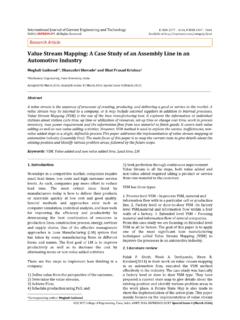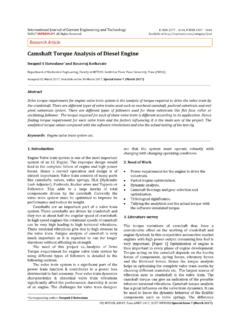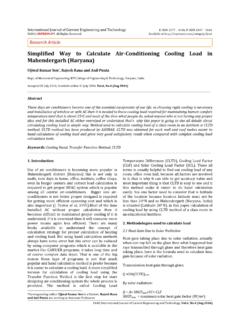Transcription of Supply Chain Management: Some Issues and Challenges - A …
1 946 | International Journal of Current Engineering and Technology, , (April 2014) Review Article International Journal of Current Engineering and Technology E-ISSN 2277 4106, P-ISSN 2347 - 5161 2014 INPRESSCO , All Rights Reserved Available at Supply Chain Management: Some Issues and Challenges - A Review Kiran Bala * Department of Mechanical Engineering, University Institute of Engineering & Technology) MDU Rohtak Accepted 10 April 2014, Available online 15 April 2014, , (April 2014) Abstract India is becoming a global manufacturing hub. Increasing demand in domestic and international markets is opening a new world of opportunities for the Indian Industry.
2 Increasing competition, due to globalization is making inevitable for the Indian industries to provide cost effective quality output with stringent delivery schedules. Issues in Supply of inferior quality, delayed Supply , unwarranted cost escalation, etc. would adversely impact the credibility and business potential of the Indian industry. Amongst many difficulties faced by Indian manufacturers, Supply Chain disruption management is a major issue, which can result in large tangible and non-tangible losses. In current study lot of research has been done to understand what the Supply Chain Management is and how it is affecting organizations, what are different Challenges and it can be proved as a tool for improving overall performance in today s global competitive environment.
3 Keywords: Supply Chain management. 1. Introduction 1 In the current competitive scenario Supply Chain management assumes a significant importance and calls for serious research attention, as companies are challenged with finding ways to meet ever-rising customer expectations at a manageable cost. To do so, businesses must search out which parts of their Supply - Chain process are not competitive, understand which customer needs are not being met, establish improvement goals, and rapidly implement necessary improvements. The term Supply Chain management has not only been used to explain the logistics activities and the planning and control of materials and information flows internally within a company or externally between companies (Christopher 1992, Cooper et al.)
4 ,1997 and Fisher, 1997). Researchers have also used it to describe strategic , inter organizational Issues (Cox, 1997, Harland et al., 1999), to discuss an alternative organizational form to vertical integration (Thorelli ,1986 Hakansson and Snehota, 1995), to identify and describe the relationship a company develops with its suppliers (Helper, 1991and Hines, 1994, Narus and Anderson, 1995), and to address the purchasing and Supply perspective (Morgan and Monczka, 1996 and Farmer, 1997). Supply Chain Management is a reverse of prior practices where manufacturers supplied product to customers.
5 Now customers tell suppliers how and when they want their inventory delivered. The driver behind Supply Chain Management is to remove inefficiencies, excess costs and excess inventories from the Supply pipeline which extends from the customer back through *Corresponding author is a Research Scholar his suppliers and through his suppliers' suppliers and so on back. By having the program driven by the customer, it is hoped that inventories, caused by uncertainties and slow response, will be significantly eliminated. While there are sales incentives to major suppliers with the carrot of category management or similar programs, the success of Supply Chain management rests with logistics .
6 Functional areas of logistics : 1. Network Design 2. Information Technology 3. Transportation 4. Inventory and Storage 5. Warehousing 6. Materials Handling, Loading and unloading 7. Packaging and Re-packaging It should be noted that Supply Chain management has both hard ( , technical) and soft ( , people) aspects, reflecting the fact that the field is at the intersection of many disciplines, such as marketing, procurement, management, operations research, logistics , and so on. It might be supposed that social network analysis originating as it does in social psychology would have its greatest and most natural application on the soft side of SCM, helping to understand how patterns of personal relationships translate to competitive advantage through diffusion of information, social control of opportunism, coordination and aid and so on (Stephen P.)
7 And Xunli, 2009). The initial benefits of Supply Chain management accrue to the customer, the initiator of his Supply Chain . He earns the reduction in inventories by driving out excesses inventories which he must purchase, store and be Kiran Bala Supply Chain Management: Some Issues and Challenges - A Review 947 | International Journal of Current Engineering and Technology, , (April 2014) responsible for. The impact of Supply Chain management to the supplier may be more difficult to classify, initially, as benefits.
8 They may vary, but may include: Fewer orders initially while the customer draws down excess inventories. Small and more frequent orders. Vendor carries inventory, not the customer. Higher warehousing costs for picking smaller and more orders. Higher freight costs for shipping smaller order and more orders. Penalties for not meeting the customer's requirements. Possible loss of business for not meeting the customer's requirements. Suppliers play a crucial role because they help Indian firms to improve Supply Chain cost, responsiveness, reliability and its competitiveness. Therefore management of sourcing in terms of Supply Risks ( , delays in receipt of the material; or mismatch in quantity supplied; or material being of inferior quality or damaged; or the alteration in commercial terms delaying the Supply ) is very crucial.
9 A solution to this problem is to manage Supply delays by managing the Supply risks. Supply Risk is defined as, The potential occurrence of an incident associated with inbound Supply from individual supplier failures or the Supply market, in which its outcome results in the inability of the purchasing firm to meet customer demand or cause threats to customer life and safety . This means non availability of the required material at the required time in spite of the order being placed for input materials on time and delivery date / quantity / cost are agreed with the supplier well in advance as per the agreed norms.
10 If a company has one hundred customers, he may have one hundred customer practices. This is the most challenging job for SCM to keep all the customers satisfied rather delighted. Emphasis is presently on the initial customer-supplier link. (Ketkar and Vaidya, 2012) The effects ripple through the Supply Chain , it is more like a "whisper down the lane" impact, where suppliers are not clear as to their role and what they must do. Customers want more quality, design, innovation, choice, convenience and service, and they want to spend less money, effort, time and risk. The Supply Chain of a company consists of different departments, ranging from procurement of materials to customer service.









